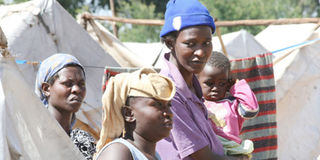Breaking News: At least 10 feared to have drowned in Makueni river
Ethnicity and elections: Which way for Kenya ahead of 2017?

Internally displaced victims of the 2007 post-election violence. PHOTO | FILE
What you need to know:
There are other solutions. Kenya is still laying emphasis on conflict resolution. The National Cohesion and Integration Commission is dependent on laws against hate speech and on post-conflict visits, meetings and investigations.
We have, in a sense, also tried a Scandinavian strategy by devolving into 47 counties. A good trial, but suddenly wheelbarrows have gubernatorial prices and county officials are guzzling taxpayers’ money.
It is the year 2016, in the run-up to the 2017 elections that will come a decade after the ugly events of 2007 that drove Kenya to the very edge of hell. International intervention led to formation of the Grand Coalition government, where relations never quite
thawed; worsened by the dragging of Kenyan citizens to the International Criminal Court (ICC) in The Hague; then to the 2013 General Election that was not resolved at the ballot, but in the Supreme Court, where the judges reached a strange verdict.
The next elections will be seen from a political context. Some communities feel left out of government. How do Kenyans avoid marring elections with negative ethnicity? How do we vote without ending up at Serena Hotel for mediated talks or the courts?
In May, 1995, Maseno University and Unesco held a conference at Mid-West Hotel in Kericho on ‘Ethnicity, Nationality and Democracy in Africa.’ At this conference, scholars ventilated on the ethno-relations in Kenya and other African countries. Many
never knew that only a few years down the line a catastrophe would visit our country.
The media had been duly invited to cover the proceedings. I recall one or two reports on the conference. The numerous presentations on the possible Armageddon if Kenyans continued to view one another in tribal terms were roundly ignored. The proceedings were later published and filed away, as shelf-bound academic references.
In the Saturday Nation of November 21, 2015, David Ndii, albeit inadvertently, brought the 1995 conference into focus. Ndii wondered: “How is it, after 50 years of independence, after 20 years of democratic reforms, culminating in one of the most progressive constitutions in the world, we end up with the mother of blundering Kleptocracies”. He went on to offer an answer, that, “we all know the answer. It’s called tribalism”. At the end of his analysis, Ndii offered a solution in question form — “If we cannot marshall the wherewithal to be a society where we all, rich and poor, Christian and Muslim, cut and uncut - can live with dignity, why not agree to go our separate ways amicably now?”
Kenya is not a listening nation. Ndii’s concerns, like that of those gathered in Kericho in 1995, are likely to be mutely forgotten. Yet the vagaries of tribalism keep revealing themselves. In the book, The S.M. Otieno Case: Death and Burial in Modern Kenya, Justice J.B. Ojwang’ wrote: “Unlike in the more material sphere, such as science and technology, in the area of social phenomena it takes an upheaval to jolt society into awareness.”
It would seem that it is only another 2007-2008 kind of upheaval that would wake Kenyans up from their slumber. Unfortunately by the time a country is jolted, it is usually too late.
Ethnicity and its sordid aspects is not a new societal phenomenon. Sociolinguist Walt Wofram recalls the biblical experience of 3,000 years ago, citing the book of Judges 12:5-6, when the Ephraimites were executed at the fords of the Jordan just for not being able to pronounce the Hebrew word Shibboleth (meaning ear of corn) to the satisfaction of their adversaries, the Gileadites. In the 1994 Rwandan genocide, it is said, the shape of thenose either saved a person or earned him/her death.
Scandinavianisation has been cited as a way of bringing peace where there was perennial conflicts. The Scandinavians were forcefully placed under one state bloc in the 19th century under the Swedish Crown and today they are parted into four separate nations, in peace and with the highest per capita incomes.
The Scandinavian prescription may not work for every multi-ethnic state. In any case we have Somalia next door — one country with one culture, one language, and by and large one religion. Yet clannism has almost brought Somalia to a situation statelessness.
There are other solutions. Kenya is still laying emphasis on conflict resolution. The National Cohesion and Integration Commission is dependent on laws against hate speech and on post-conflict visits, meetings and investigations.
We have, in a sense, also tried a Scandinavian strategy by devolving into 47 counties. A good trial, but suddenly wheelbarrows have gubernatorial prices and county officials are guzzling taxpayers’ money.
What needs to be done in Kenya is to shift from conflict resolution to peace management. This would involve cogent public information and education, comprehensive peace building programmes and eradication of grudge-enhancing attitudes and actions.
In a country like Kenya, it is time to engage in serious inter-ethnic diplomacy.
In a related comparison, James Baldwin, the great African American writer, in dealing with the race complexities of his country, wrote of “the wrath to come” should the Americans not “dare straightaway everything”. The consequences were dire according
to Baldwin’s quotation from the Biblical prophecy recreated into song by a slave – “God gave Noah the rainbow sign, no more water, the fire next time”.
Owen MCOnyango teaches at Maseno University. [email protected]




